The Writing of Radiance: A(n Illustrated!) Look Back
[chanting] Lore dump, lore dump, lore dump
Welcome to The Story Scrapbook, a fiction newsletter by E.B. Howard. If you’re new in town, check out my Fiction Directory for navigation.
This post is an inside look at the development process of my major focus this last year, my superhero serial Radiance. If you haven’t read it already, proceed at risk of spoilers!
This post may be truncated in email, due to the large number of images. Just click through to view in your browser.
“It’s been a weird year.”
—Jacob Jones and, also, me.
Yeah, I agree with Jake a lot more often than I expected to.
One note before we dive in: Due to a combination of technology failures and moving house ten times in a decade, I’ve lost most of my writing and all but a very few pieces of my art from before 2021. Alas, it is what it is. Unless otherwise noted, all illustrations are reconstructions that I’ve done from memory over the last month or so.
In the Beginning
Radiance takes place in an alternate version of 2013-2014. It was around the same time, here in our timeline, that I started writing something just recognizable as its beginning.
I’d written masked-hero stories before that, inspired by tales like The Scarlet Pimpernel; sci-fantasy adventure tales, too, mostly in the vein of Indiana Jones. However, I’d never combined them until a friend with one foot in the Marvel comics fandom convinced me that we should spin up a contemporary superhero universe together. I love collaborating, but my side characters, subplots, and worldbuilding always seem to multiply faster than I can weave them into shared stories. I began tossing around ideas for alternate timelines, swapping characters in and out, never exactly settling on anything except for the Big Good—Jason Penn, aka The Emblem, soft-power symbol of These United States—and the Big Bad—Archangel, one of those nebulously post-Soviet bad guys, and noted One World Government enthusiast. …as long as he ran said One World Government, that was.
Archangel 1.0: much edgelord, very God complex.
He already had the mind control powers at this point, which meant he really demanded to be more than a standalone antagonist. In a narrative where mind control is otherwise nonexistent, you can’t just throw a mind-controlling villain in there! You have to ease into it, so that everyone fully understands the horror. Before you introduce him, you introduce the mind he’s controlling.
No, that’s not Lady Radiance. We’ll get there.
Lord Hades took over the narrative quickly, emerging fully-formed as the same character he remains in Radiance. His archetype is one I used to write a lot of, but then set down for a long time; picking it up again and then having to think it through critically, while writing, has been…interesting. I was certainly much more sympathetic to Hades in my early twenties, when having a fixer-upper boyfriend felt like a virtuous life choice.1 I mean, I still love him! But now I love him like my shiftless nephew with two failed stints in rehab who’s about to get sat down for a come-to-Jesus meet’n.
Getting older is fun like that.
Anyhow, half the reason Archangel was struggling so much with the ‘taking over the world’ thing was the quality of his minions. Radiance puts a hard limit on his powers by requiring physical contact with the psychic goo, but I never established why this version wasn’t just pulling the strings on world leaders and calling it a day. Still—for whatever reason—he was mostly stuck with Lord Hades. And Hades, in addition to not being terribly evil, had a hopeless crush on big-name heroine Lady Eos2 (who sometimes dated Emblem, but would absolutely have picked Hades if she’d thought she could get away with it.) And everybody knew it. The status quo reigned happily until Eos managed to coax Hades into defecting to the good, allowing Archangel to switch to some real bad guys.
(Which was, as it turned out, the whole reason he’d been encouraging Hades to get attached to her in the first place. Whoops.)
2015 maybe? When did he have lightning?? I worked so hard on this, I hate that the photo’s so blurry. Of course the original is long gone.
The launching point for Radiance, You’re My Lady, I’m Your Fool, started out as the sole survivor from this set of drafts, ’80s music and all. However, I didn’t keep very much of the context. Adapting it into a short story without a firm plan for a serial had thus left me with a ton of…let’s call them opportunities!
“You’re My Lady” originally paired Hades with Lady Eos. Part of adapting it was simplifying the concept, though, which included swapping out Dawn for Christabel to eliminate the love triangle. But now how do I justify Archangel’s interest in Lady Radiance?
While Lady Radiance theoretically existed in this universe (as Lady Eos’ West Coast rival, whom Dawn refused to believe was really that nice), I had never actually written about her before; my memories were sketchy, and I no longer had my notes. How do I flesh out her character into somebody I want to write a long serial about?
I’d kept more of the setting intact than I probably should have. I mean, if it’s not about the Emblem or Lady Eos, why are we in DC?3 And what about the global geopolitics?
Where did “You’re My Lady” belong on the outline? That is, would this be a story about a redeemed Liam fighting his former master while adjusting to being a good guy4, or a story about Christa trying to redeem him in the first place?
Also a perfect illustration of my two main struggles with Radiance art:
1) It’s much harder than I expected to design and draw costumes consistently.
2) Light on one side and fire on the other make highlights and shadows a nightmare.
Nevertheless, I wrote and posted the first part of Radiance #1 almost immediately, without having any idea at all where I was going with it. On the one hand, good for me: it publicly committed me to a new project while the iron was hot and everyone was interested. On the other hand…I had no idea where I was going.
There was no outline. I didn’t know what the themes should be, or what a happy ending would look like. There was no firm worldbuilding in place. I hadn’t even read my surviving source material on the secondary characters who’d been so roughly patched in from my other Emblem story, Lionheart. I still don’t know if I would recommend this approach or not! I mean—there’s no substitute for getting the work done. Whatever you have to do to get the work done, do that. However, Radiance #1-1 feels off to me; I think you can tell it’s the pilot, and I don’t know that it adequately introduces the story we ended up with.
Well, onward. Through the magic of Google Docs versioning, I can flip back to May 2024 and watch myself writing the Radiance outline, which is just as creepy as it is useful. With the beginning of the story already set in stone, I went straight to development on the third plot point (“all is lost” moment), having learned from previous work that I often stumbled on it. Within about a week, I had the basic events between the end of “You’re My Lady” and Lady Radiance going into cryo laid out, including the conversation in the lounge. It was a start, but not all there yet, of course—my summary includes Spacewalker as an active hero getting captured along with the Lady, and Hades’ backstory still needed work.
It shakes out that Archangel is an ancient and very powerful lich, the devoted servant of the Darkest Powers There Are. In order to stay undetected and preserve himself, he’s split his power into channels and phylacteries. Liam is a host to one of these, a living portal to Hell Itself.
(…dang it. On reflection, that actually makes more sense than what I ended up with.)
This done, I pulled out everything I could find for Lionheart and started to read.
“#@$%,” quoth the author.
In the Grim Darkness of the Near Future
Let’s flip back to 2016. In a twist of fate, I myself had recently sold my soul to the United States government and moved inside the Beltway, and was starting to suspect that when this place is your world, the world is always ending. I walked a lot, I wrote a lot, and I listened to a lot of music. Lionheart was one of the results; I’d wanted to write a webcomic for ages at this point, and I decided to pick up Emblem and Archangel again and just try it. My original scripts are long gone, but I still have most of the arc-level outlines. The story interested me. All masked hero stories are about identity, and everyone involved was dead wrong about who they thought they were. Many of the subplots turned on being put to the test and having to confront your false ideas about yourself. I didn’t use that concept in the end, but it proved to be a useful starting place.
In any case, two big problems immediately came up during this reread. One, I couldn’t just lift the characters as I’d hoped (including my modification of Jason into Jacob.) Some of them were counted right out by my setup, and I had accidentally mangled the rest to varying degrees while working from memory. Two, neither could I use much of the plot. I had forgotten about the tone whiplash between my first Emblem stories, which were a lighthearted take on a reluctant villain, and this one, which was…not.
Jason: I don’t get this.
[Baz drops a sheet over the girl on the altar.]
Baz: Why?
Jason: It’s in the cult leaders’ handbook. You don’t kill everybody off until you have to, otherwise you have nobody left to worship the ground you walk on.
Baz: Seems t’ work out for Archangel. Leila said he’s already started over, right?
Jason: Yeah, but why not just take the old followers with him? Seems like an easier sell than mass suicide.
Baz: I dunno. Maybe the death’s the point.
[Wide panel: the room full of corpses.]
Jason: What the hell are we dealing with…?
Radiance gets pretty dark in places, but Lionheart hardly ever got its nose above water. I’d collapsed the love triangle here too—while keeping the Emblem, I’d removed Lady Eos and replaced Lord Hades with a (metaphorical) opposite-sex clone, a snarky, waifish villainess named Morana5. If this sounds maybe not too bad, consider that Archangel had already become the master manipulator we all know and hate, but was still corporeal; a note on his character remarks casually that he’s “groomed Siren and Morana from childhood as the ideal weapons and wives.”
It didn’t get better from there.
Lionheart’s outline opens with Archangel winning, successfully using Morana to distract her nemesis/crush Emblem from a devastating attack that loses him everything, rank and suit included. The rest of the first act is Emblem (now going by Lionheart) on the run from the government, trying to put some kind of life back together, as Archangel’s doomsday cult grows increasingly powerful and their prophesied date for Armageddon inches ever nearer. All the while, he’s descending into an obsession with Morana, who’s been missing since his fall from grace.
Of course the new ally his friends rescued from drowning is Morana with amnesia. Of course Archangel is using her to spy on them. And of course it’s actually a Little Mermaid plot where she made a deal with her Master to try to get out of this supervillain thing, but Archangel rigged it against her (see: amnesia) and she has to go be evil again when her own villain identity inevitably wins out for Lionheart’s attention.
Oh, yeah, and in case this relationship ever ran low on obstacles, her skin dealt necrotic damage.
Morana then gets her powers upgraded, vows revenge on her onetime love interest, and remains a serious threat for the rest of the story as The Shadow Queen. Lionheart…does not deal with any of this well. Meanwhile, as the story progresses, minor characters who vanished during the plot setup start to turn up again as psychically-brainwashed cultists—either the heroes have to fight their former friends (no clones here), or said friends are being killed so that their souls can add to Archangel’s power.
We are not even 25% of the way through this outline. Seriously, it doesn’t get better.
Along the way, Lionheart was responsible for much of Sylph’s character development. While she was present in the originals, she’d never really made it onscreen; she was a major part of Lionheart, though, entering the story shortly after The Shadow Queen did. When Archangel lifted Morana’s amnesia and summoned her home, she’d initially felt ambivalent enough to track down her sister first and ask Sylph to erase any memories that Archangel might use to hurt her former allies. Sylph told Morana that she couldn’t do that, and she later told Lionheart that they could use those memories to get Morana out of the mind control.
On reflection, actually, I did just lift Sylph from Lionheart.
Of course, neither of these things were true. Sylph needed someone to get her close enough to Archangel that she could remove herself from his memories, allowing her to stop living in fear that he would come after her—which was really all that she cared about, having seen that Morana was willing to go back. However, since that would prove more difficult than expected, she ended up sticking with the heroes long enough to earn a little redemption arc of her own. A tragic redemption, of course. (For those of you who thought I was going to kill off Sylph in Radiance…you were close. In this one, she died in the final fight with the Shadow Queen.)
Also featuring in Lionheart were three new characters whom I carried over into Radiance, though with some changes both accidental and intentional: Dr. Marcos, Marissa, and Chained Lightning.
[Josh Keaton voice] and then there’s this asshole.
Lionheart’s Sebastian was one of Jason’s pre-Emblem friends, an old Army buddy who was also the kind of crazy that makes you wonder how he got his death wish, then regret asking. He had no superpowers at all, and was moonlighting as Chained Lightning “for the hell of it” while working on the very illegal mech suit of his dreams. Never more than one mistake away from slipping off the bottom rung of the antihero ladder, he knew how to feign having everything together, but was, in fact, a dysfunctional shambles of a human being—it went to show how far Lionheart had fallen that he was now teaming up with this guy.
Louise: Hey, Baz? Are we the good guys?
Baz: That’s cute, Lulu.
Baz: There’s no such thing as good guys an’ bad guys out there. It’s our guys an’ their guys.
Baz: Am I gonna let anybody put you and Jase back in cages? No. Am I gonna be tore up about what I might have to do to make that happen? Also no. You can say for yourself if that makes us the good guys or not.
Louise: I thought I was at least on the side that didn’t want to rule the world.
Baz: Everybody wants to rule the world, baby girl.
Louise: Jason doesn’t.
Baz: You an’ me both know how often that boy’s been hit in the head.
Oh…I forgot to tell you about Louise! L018X-48, aka Louise, was a human-alien chimera—an organism composed of two embryos fused together—created by the scientists who also ran the Emblem project. This went a little bit better for her than it did for Radiance’s Archangel. She was normally a precocious, outgoing child of maybe ten or eleven, but she had an inner core of existential angst due to being a synthetic creation raised in a lab (and slated to be quietly euthanized for political reasons before Jason rescued her.) She refused to use her shapeshifting abilities except in the direst emergencies, and would get into moods where she’d exclusively refer to herself in the third person as ‘Monster Lulu’. I do not think she knew anybody who wouldn’t have committed multiple murder for her in a heartbeat, Baz especially.6
But, yes, back to Baz. Though the man amused me, I planned to kill him off. I wasn’t sorry, either! It was what the story needed, what the other characters needed, and also probably the best he could have expected out of all this.
…well. Until somebody came along to wreck that.
POV: it’s poetry in motion.
2017 doodle. That was an unidentified piece of supervillain tech that just detonated off-panel, btw. She might have remembered to put up the shielding…or she might not have.
You see, the scientists weren’t part of the premise. I created them later, out of necessity: they showed up about three-quarters of the way through as minor antagonists whose subplot drove the pivot into the next arc. If Chained Lightning was an antihero, these two were anti-villains. They were mad scientists messing around with superpowers on the taxpayers’ dime, but their irresponsible research had institutional approval, and their intentions were basically good. With the scale of bad guys going all the way up to Mr. Jonestown himself, they normally wouldn’t have registered at all. However, Dr. Marcos had been pushed over the villain line by an experiment gone all too predictably wrong, and it was up to fresh-faced Intern Marissa to clock the reluctant freelancers passing through town and convince them to help, lest some more official and less sympathetic heroes get there first.
Lionheart: So…you want us to stop your evil PhD supervisor before he goes full mad scientist on the nearest city.
Marissa: He’s not evil.
Marissa: He’s just…under a lot of stress. [mumble] Some of which might be my fault.
Sylph: I can imagine.
Problem one: Chained Lightning was established as a flirt. It was just how he talked to women. It was condescending and superficial, it was absolutely a defense mechanism, and it regularly got him into trouble—and Lionheart, by association, which was why they went to some efforts to keep him from meeting their newest client before it was absolutely necessary.7
Problem two: Marissa, whose questionable judgment was also established, actually didn’t mind at all.
The expanded alternate take, because there is no universe where this hasn’t happened at least once. This includes Radiance canon.
It was like throwing a rock off a cliff. You blink and that thing’s gone, bro. No amount of author interference was going to get his heart back. There was no flag red enough to scare her away, and there was no subplot I could write for him that wouldn’t jump the rails to follow her anywhere. And as sweet as that was, it immediately became an enormous story problem. As in, the detailed version of the outline abruptly stops here.
Baz: It’s one simple rule, darlin’. Civilians don’t get to carry weapons on my ops.
Marissa: It’s not a weapon, it’s a keychain.
Baz: It’s a keychain with a damn mini-death-ray an’ a magnifying glass on it!
Marissa: Okay, big boy. First, per the State of Texas, that magnifying glass is a legally distinct entity from the mini-death-ray. And second, what are you worried I’m going to do with it? Trip on my shoelaces and start death-raying somebody’s ankles??
Baz: Three an’ a half academic degrees, I’d hope you could keep your shoelaces—oh, for f’s sake. No, no, you stand there an’ look pretty. I’ll tie ’em.
—————————————————
Leila: Were we going to bring the intern with us?
Jason: Actually, I thought they could keep each other busy while you and I handle it, and a job might go the way I intended it to for once.
Leila: Personally, I wouldn’t trust them not to burn down the neighborhood while we’re gone.
Jason: [Disappointed sigh.] Yeah, me neither.
The last work I have for Lionheart is a series of disjointed background jokes like that and a note that Marissa would eventually realize what Baz was after and agree to go out…but he only had a few more chapters to live. The next plot point required that Lionheart have his perspective broken down completely, and I had been preparing all along for Archangel to use a combination of psychic suggestions and illusion magic to get him to kill Chained Lightning. Breadcrumbs. Foreshadowing. Hubris. This was the consequence of Jason spending the whole story running from the question of to whom and to what he would be loyal. This was Leila’s refusal to erase Morana’s memories of her time with the heroes coming back to bite them all. In Baz and Jason’s initial first-act meetup, one of them even alluded to a friendly-fire incident they’d been involved in with the ANP years before. This was baked in.
This was good, though, right? Hadn’t I just handed myself the perfect way to make his death even more painful? Ironically, maybe if the overall tone hadn’t been so dark, I could have gone through with it. But when I saw that keeping my pivot point for the protagonist would require coldly, deliberately crushing the first and only ray of unalloyed happiness in the whole story…ugh. I couldn’t do it. (I know. I know. I’m just as shocked as you are to find out that I have lines.) Naturally, I never quite figured out how I was going to rewrite somewhere between 5% and 100% of the comic to account for this. There were a couple of other possibilities, but they seemed even more heartbreaking—besides which, I had no idea what reason I could find for the scientists to stay in the plot. I took a break from Lionheart to think about other things, ended up creating a whole different set of characters to be obsessed with for years on end, and had never gotten back to it.
“Well, it’s okay,” quoth the author. “I’m sure Baz and Marissa wouldn’t derail my story plans twice.”
…
…Hold on, y’all, I’m still laughing too hard to type. Give me a second here.
You know what, this post is already pretty long. I’ll, uh…oh, boy. I’ll see you next time with a discussion of what it was like to actually write this serial…
Did I successfully convey with Radiance what a TERRIBLE IDEA THIS IS? I’m starting to think I didn’t. FOR THE RECORD, IT’S A TERRIBLE IDEA. Don’t do it, girls.
After the dawn goddess, yes. Because she was the established “light hero” for the East Coast, yes. …and because her real name was Dawn, yes.
Easy answer, actually: the DMV area has quite a few big research hospitals, so it makes sense for our mad scientists to operate there. Bethesda or Silver Spring would still have been a better initial lab location, though.
How I know that I’ve been thinking about this story for too long: I’m so sick of what I actually wrote that I’m currently furious with myself for not taking this option.
I also made the switch because Hades/Persephone—as fundamentally as it speaks to me and as much as I love it—has been retold often enough in the last 20 years that it’s started to feel overdone, which is why I waited as long as possible to make the parallels in Radiance explicit. Maybe in another 20 years the market will have cleared out a little, and I’ll write them into a dark romantasy about the paradox that what is sown among the dead is reaped among the living. But Morana still feels fresh, and I would love to properly cover the “drowning the death-goddess” theme somehow.
Despite the frustrating proliferation of ‘L’ names, the longer I think about this, the more I want to write Lulu into the Radiance sequel and let someone adopt her. You people are making me soft.
Just before this, they had to destroy a whole nest of superpowered cultists on their own because he’d pissed off Leila’s local contact by introducing himself with “hold up, I think I just met my future ex-wife.” Seriously, a walking disaster. When Marissa asked to meet with them, Jason made up an excuse to send Baz on a six-hour round trip to Louisiana rather than have him in the same state as a potentially delicate situation.



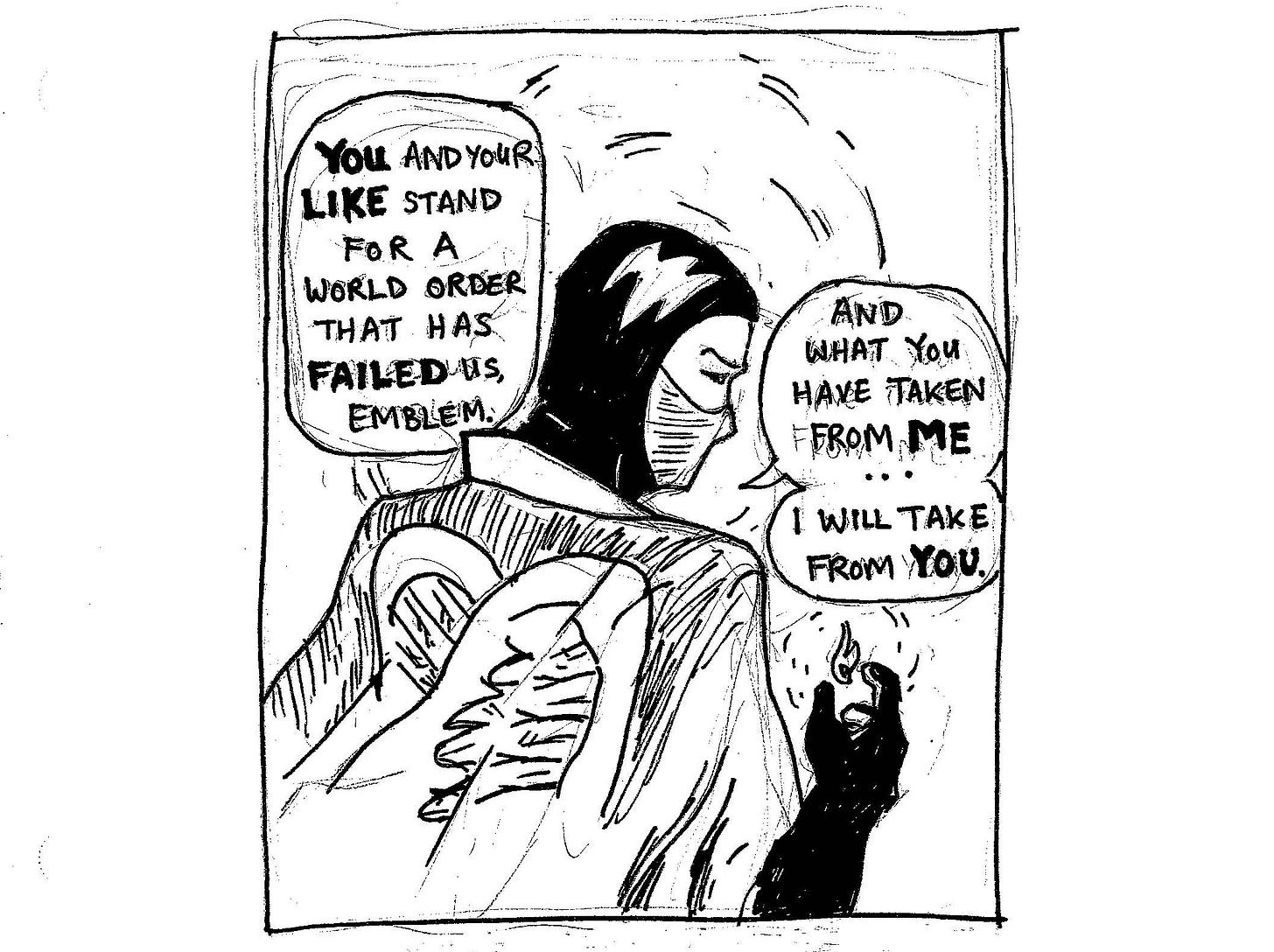
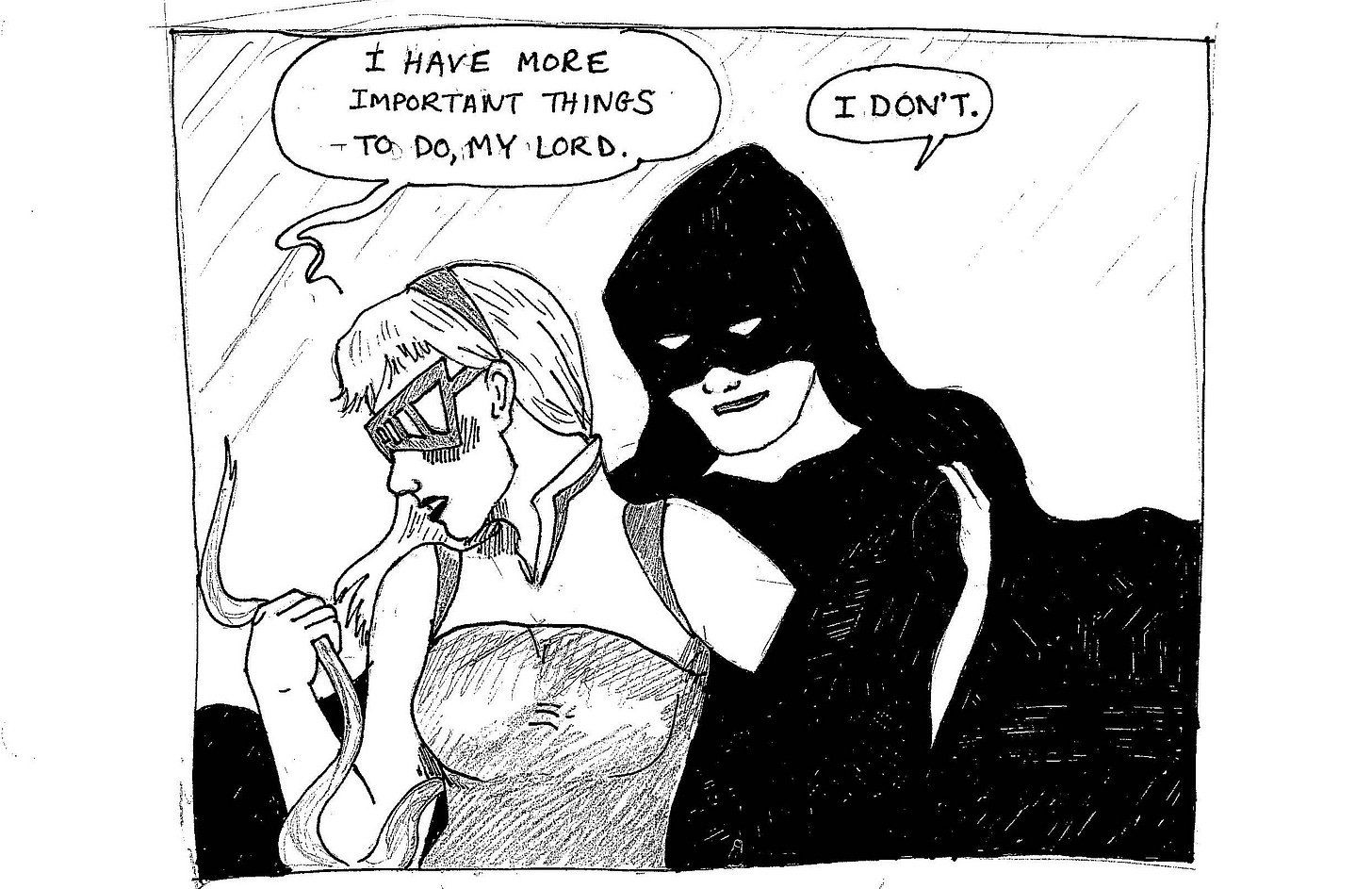
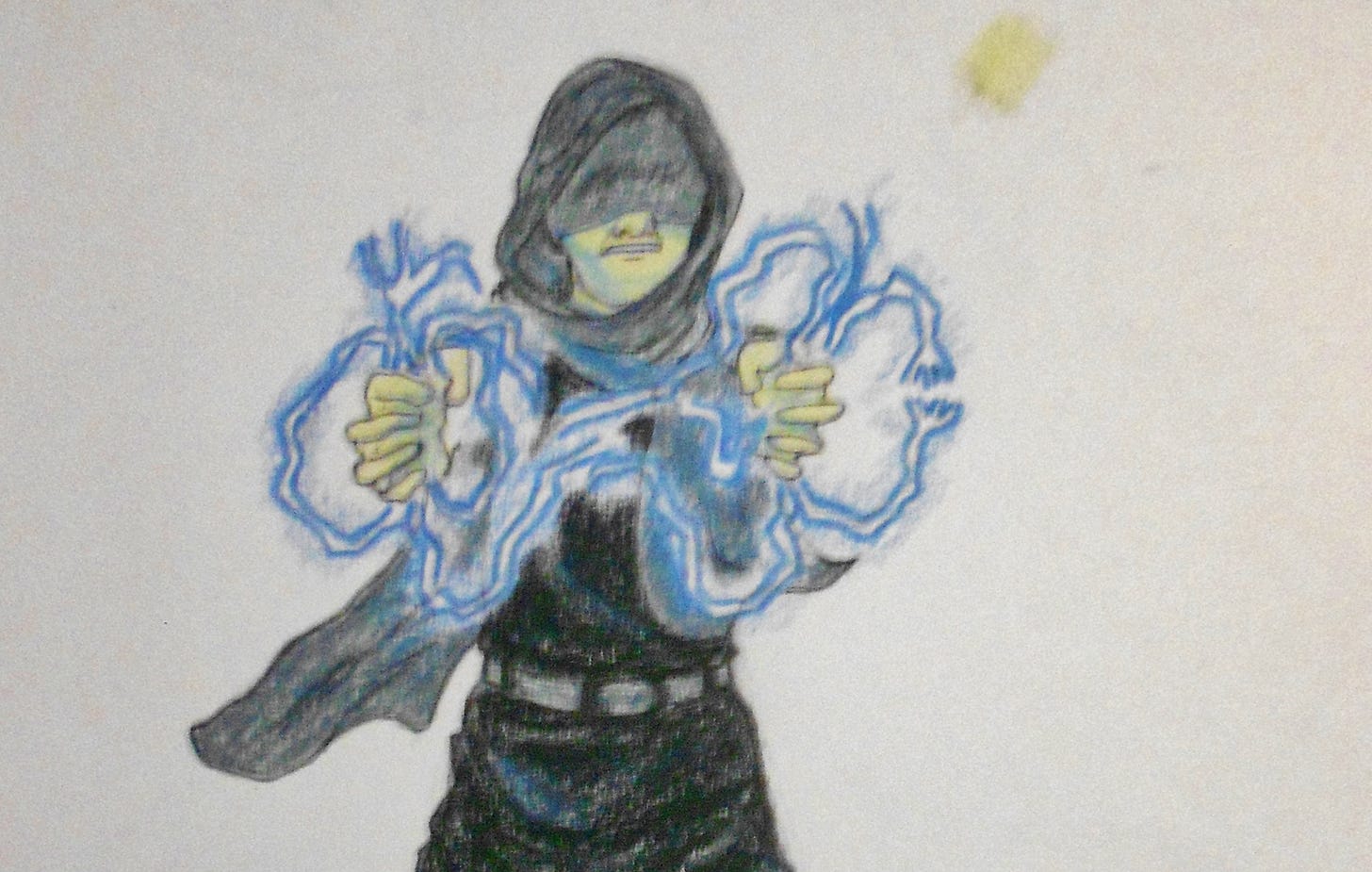

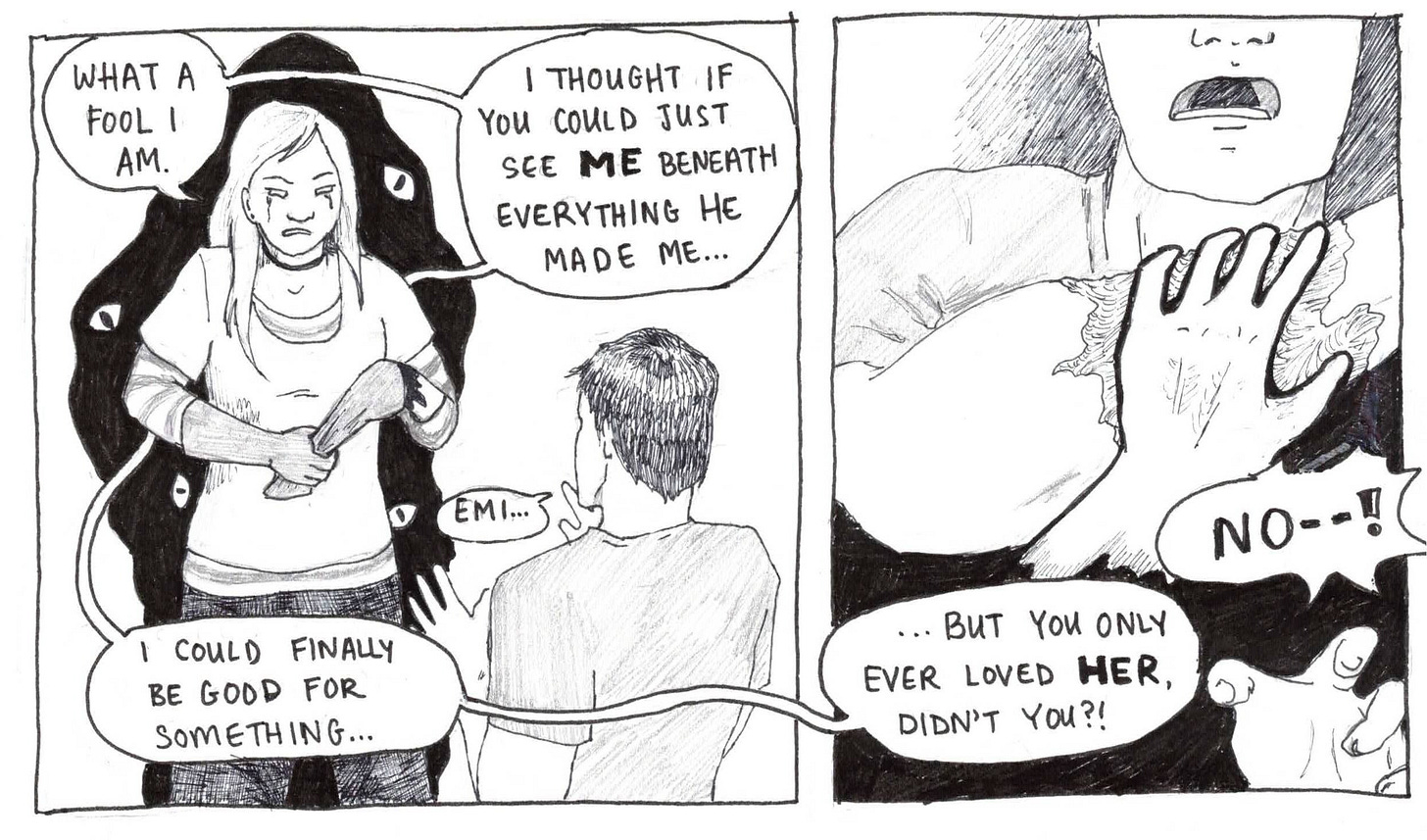



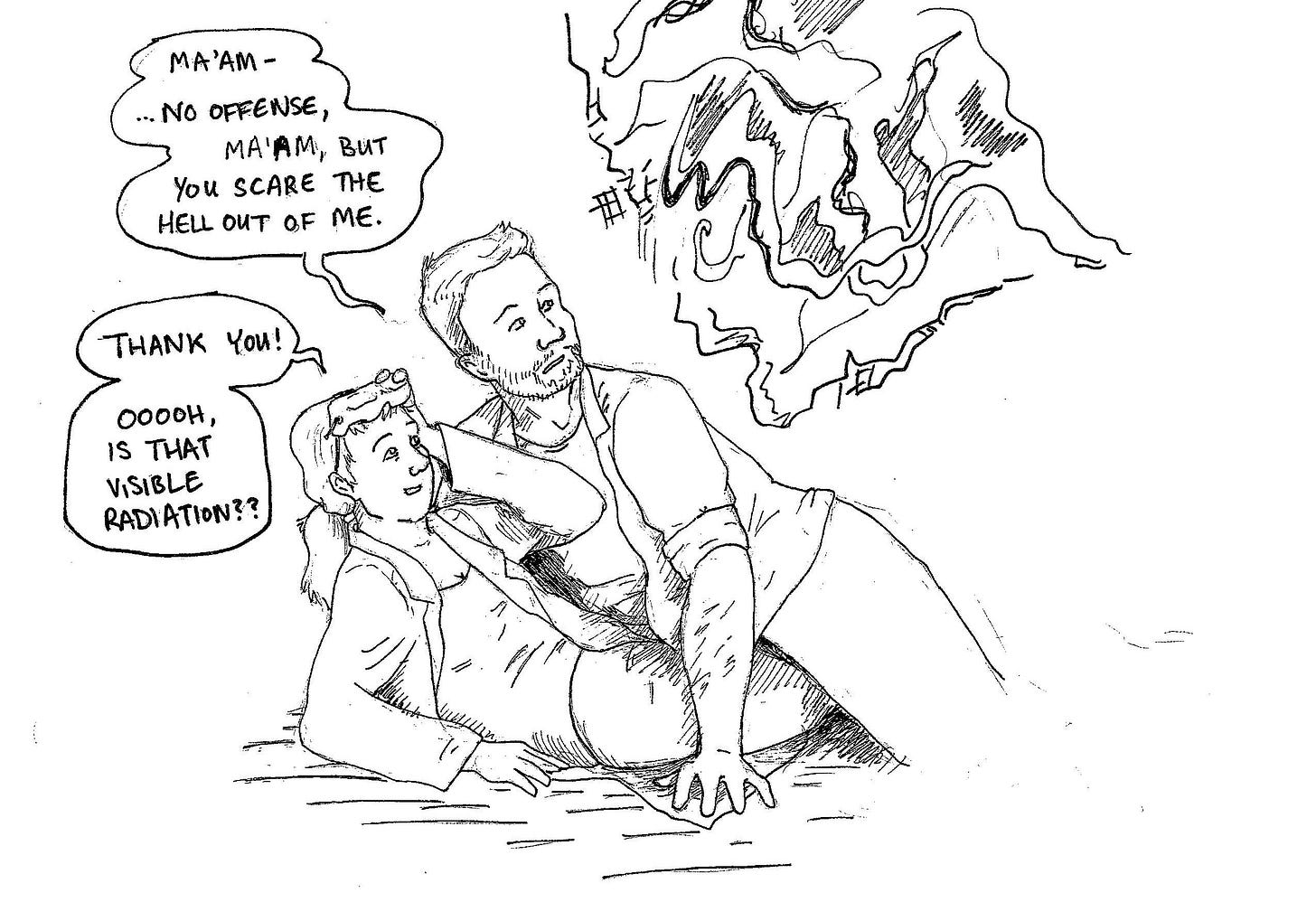
All of this was so fascinating, but Baz and Marissa’s problem-laced origin is making my day.